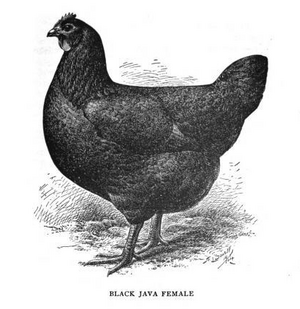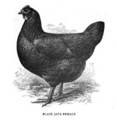Java chicken facts for kids

Illustration of the ideal Black Java female in the 1905 Standard of Perfection
|
|
| Conservation status | critical |
|---|---|
| Country of origin | United States |
| Standard | APA |
| Traits | |
| Weight |
|
| Egg color | brown |
| Comb type | single |
| Classification | |
| APA | American |
|
|
The Java is a special kind of chicken that first came from the United States. Even though its name sounds like the island of Java, these chickens were actually developed in the U.S. from Asian chickens. It's one of America's oldest chicken breeds. Many other popular chicken breeds today actually came from the Java! Sadly, the Java chicken is now in danger of disappearing. Javas are big, strong birds. They are tough and good for both meat and laying eggs. This makes them great for small farms, homesteads, and people who keep chickens in their backyards.
Contents
History of the Java Chicken
The Java is the second oldest chicken breed created in the U.S. Only the Dominique is older. We don't know exactly where its ancestors came from in Asia. The Java chicken was first written about in 1835. However, people think it was around much earlier than that. Javas were very important for meat production in the 1800s. They were most popular in the second half of that century.
How Javas Helped Other Breeds
The Java chicken is a "foundation breed." This means it helped create many other important American chickens. It contributed a lot to breeds like the Jersey Giant, Rhode Island Red, and Plymouth Rock. Javas might also be why modern Dominiques have yellow skin. Older Dominiques used to have white skin.
Official Recognition and Changes
The Java breed was officially recognized in 1883. This happened when it was added to the American Poultry Association's Standard of Perfection. This book describes what each breed should look like. The White, Black, and Mottled Java types were all in the book at first. But the White Java was removed in 1910. People thought it was too much like the White Plymouth Rock. The White Java then disappeared by the 1950s. There was also an Auburn type of Java. This type helped create the Rhode Island Red. But the Auburn Java died out by 1870.
Saving the Java Breed
By the end of the 1900s, Java chickens had almost vanished. This happened because big farms focused on only one or two chicken breeds. Also, many new and fancy breeds became popular. In the 1990s, people started working hard to save the Java. The Garfield Farm and Inn Museum in Illinois has been very important in saving Javas. They started with Mottled and Black Javas. From these, new White Javas have been brought back. The Museum of Science and Industry (Chicago) in Chicago also helps. They hatch Java chicks as part of their exhibit on genetics.
The American Livestock Breeds Conservancy still lists Javas as "Critical." This means there are fewer than 500 breeding birds left. They are also part of Slow Food USA's Ark of Taste. This is a list of old, special foods that are in danger of disappearing.
What Java Chickens Look Like
Javas are heavy chickens. Male Javas (roosters) weigh about 9.5 pounds. Female Javas (hens) weigh between 6.5 and 7.5 pounds. They have a very long, wide back and a deep chest. This gives them a strong, rectangular shape. They have small earlobes and medium-sized combs and wattles. All of these are red. Javas have a single comb. However, its shape suggests that a pea-combed breed might be in their family tree.
Java Chicken Colors
Today, Javas come in three main colors: Black, Mottled, and White.
- The Black Java has black legs and beaks. Sometimes, their legs might have some yellow. Their feathers are a solid black color. In the light, they have a dark green shine.
- The Mottled and White Javas mostly have yellow skin and horn-colored beaks.
- The Mottled Java has black feathers with white tips. This makes them look spotted.
How People Use Java Chickens
Javas are valued because they are "dual-purpose" chickens. This means they are good for two things. They produce both meat and eggs. Even though they grow slower than the chickens used by big farms today, they still provide good meat. Hens lay a good number of large, brown eggs. They also like to sit on their eggs to hatch them (this is called being "broody").
Javas are known for being good at finding their own food. They need less extra food than many other breeds if they are allowed to free range. Like many large chicken breeds, Javas are usually calm and gentle. They are also tough and can handle bad weather. Overall, Javas are great for people who have smaller flocks and want a good chicken for both meat and eggs.
Images for kids


